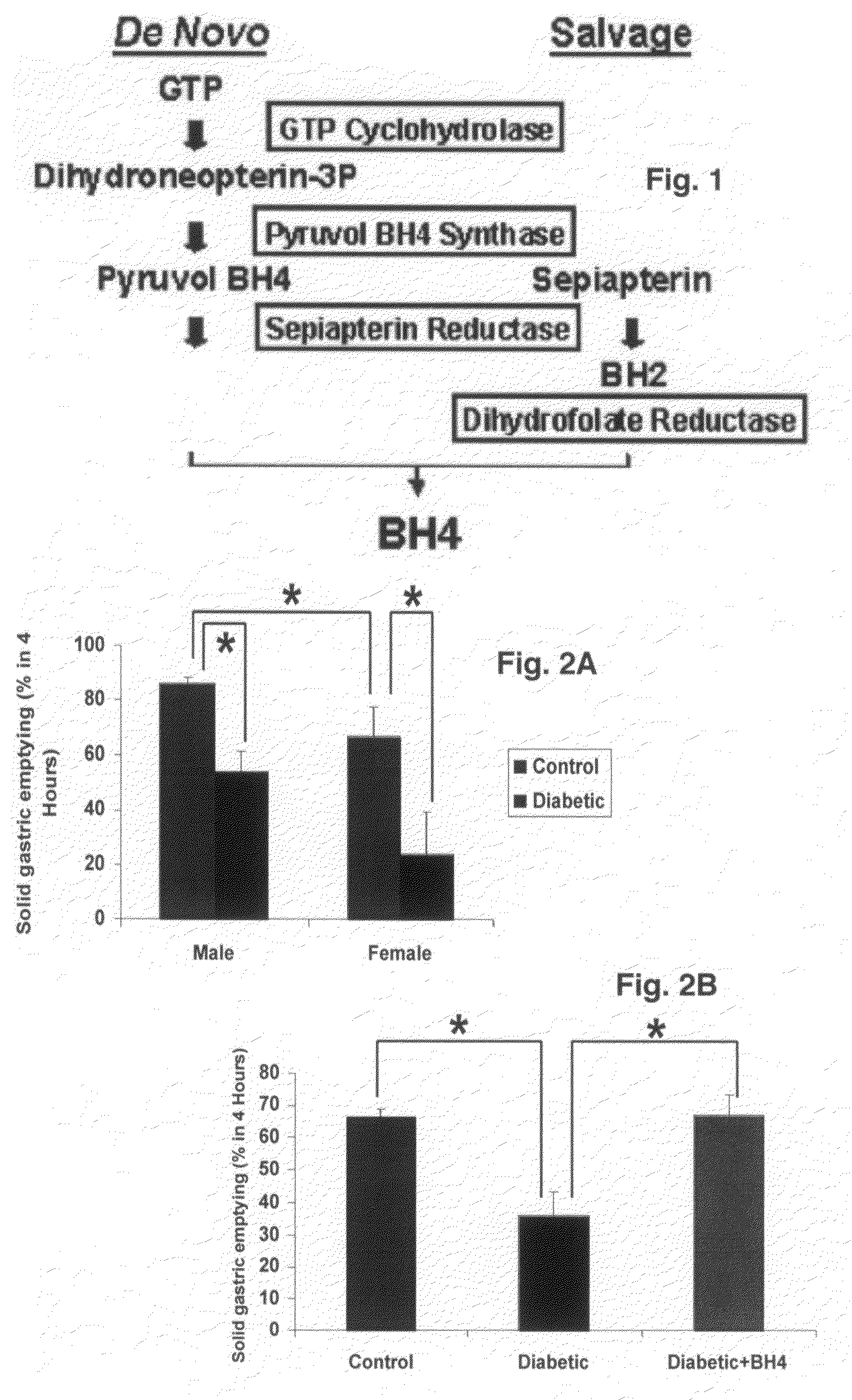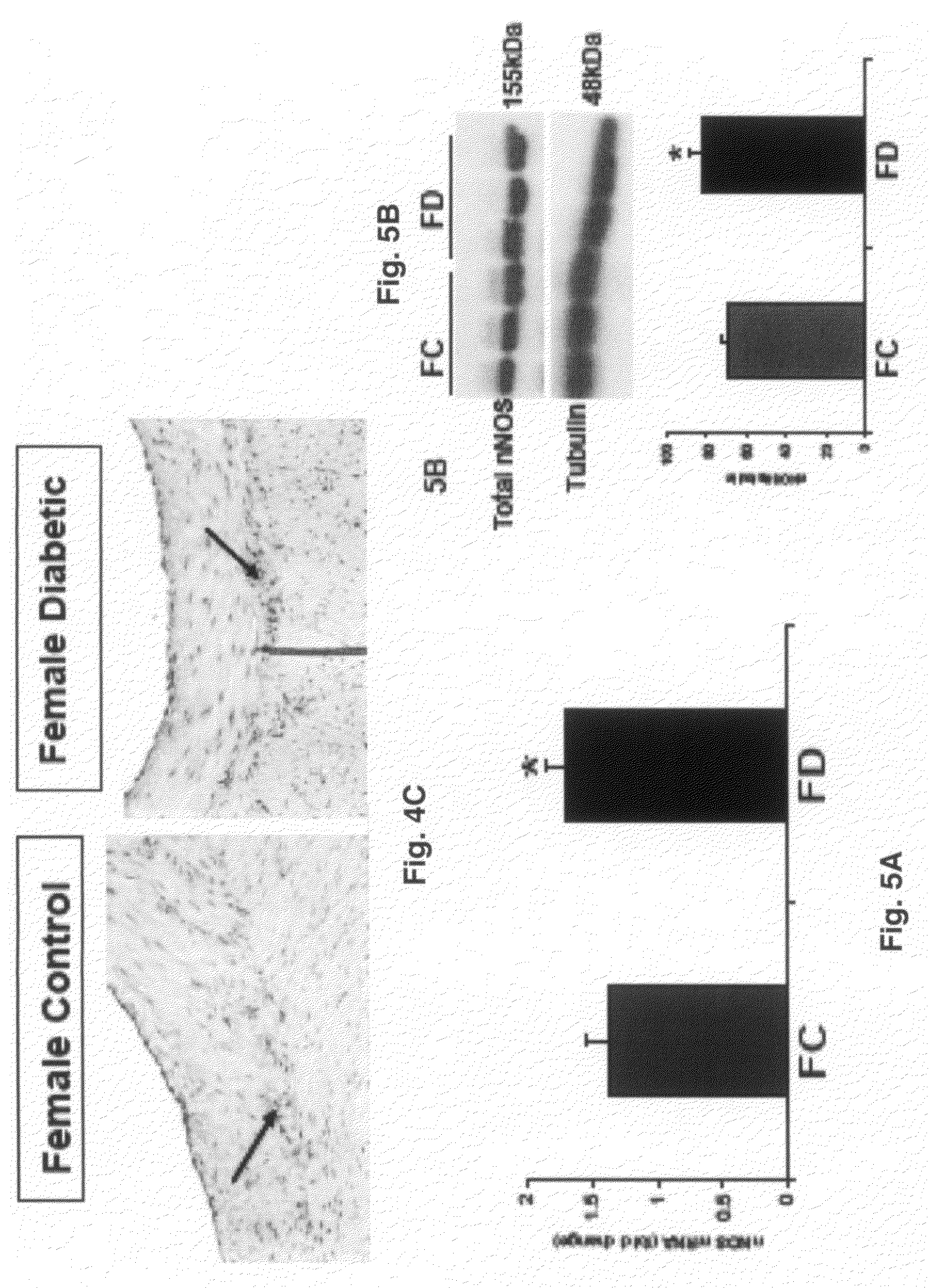Uses of tetrahydrobiopterin and derivatives thereof
a technology of tetrahydrobiopterin and derivatives, applied in the field of gastrointestinal dysfunction, can solve the problems of lack of understanding of the pathogenesis and/or pathophysiology of gastroparesis, disturbance of several gastric functions, and inability to effectively treat gastroparesis, etc., to achieve the effect of restoring gut motility in an individual, increasing expression and/or activity, and restoring gut motility in the individual
- Summary
- Abstract
- Description
- Claims
- Application Information
AI Technical Summary
Benefits of technology
Problems solved by technology
Method used
Image
Examples
example 1
Chronic Diabetes Delayed Solid Gastric Emptying in Rats
[0052]The present invention investigated whether solid gastric emptying (GE) is slower in male and female rats after diabetes induction. Additionally, whether dietary tetrahydrobiopterin attenuated the delayed gastric emptying in female diabetic rats was also examined. Diabetes induction significantly delayed gastric emptying in both male and female rats (FIG. 2A). However, females showed severe gastroparesis compared to males after diabetes induction. Interestingly, tetrahydrobiopterin supplementation completely restored gastric emptying in female diabetic rats (FIG. 2B).
example 2
Chronic Diabetes Impairs Intragastric Antrum Pressure and Sensitivity to L-NAME in Female Rats
[0053]Intragastric pressure (IGP) was measured using ambulatory telemetric device. The technique used herein is similar to that of the ambulatory manometric method used in humans to measure contractions of gastric antrum. A previous study had reported a decrease in antral contractility in women compared to age matched men by using dynamic antral scintigraphy and antriduodenal manometry. The intragastric pressure was observed herein to be lower in female compared to male rats (FIGS. 3A, 3B). L-NAME treatment significantly elevated IGAP in females and this was decreased in male rats. No change in intragastric pressure was noticed with L-NAME treatment in female rats. However, males showed an increase in intragastric pressure after L-NAME treatment (FIGS. 3A, 3B). Additionally, dietary tetrahydrobiopterin completely restored the elevated intragastric pressure in female diabetic rats. These obs...
example 3
Chronic Diabetes Impairs Nitrergic (Neurons Produce NO) Relaxation in Female Gastric Tissues
[0054]The nitrergic relaxation was investigated after electrical field stimulation (EFS). Gastric antrum (FIG. 4A) strips obtained from female diabetic (FD) rats showed an increase in nitrergic relaxation compared to female control (FC) group. In addition, it was also observed that preincubation with tetrodotoxin (TTX, 30 minutes, 1 μM) abolished nitrergic relaxation (data not shown). Further, the NO donor, (z)-1-[2-(2-amino ethyl)-N-(2-ammonioethyl)amino]diazen-1-ium-1,2-diolate (DETA-NONOate, 100 μM) was used to test whether the smooth muscle response to nitrergic signaling remained intact in diabetes. The data presented herein indicates that the relaxation responses to DETA-NONOate were similar in both control and diabetic gastric tissues obtained from female rats (FIG. 4B).
[0055]Thus, it appeared that females relied on nitrergic control of gastric motility to a greater extent than males a...
PUM
| Property | Measurement | Unit |
|---|---|---|
| time | aaaaa | aaaaa |
| body weight | aaaaa | aaaaa |
| pH | aaaaa | aaaaa |
Abstract
Description
Claims
Application Information
 Login to View More
Login to View More - R&D
- Intellectual Property
- Life Sciences
- Materials
- Tech Scout
- Unparalleled Data Quality
- Higher Quality Content
- 60% Fewer Hallucinations
Browse by: Latest US Patents, China's latest patents, Technical Efficacy Thesaurus, Application Domain, Technology Topic, Popular Technical Reports.
© 2025 PatSnap. All rights reserved.Legal|Privacy policy|Modern Slavery Act Transparency Statement|Sitemap|About US| Contact US: help@patsnap.com



